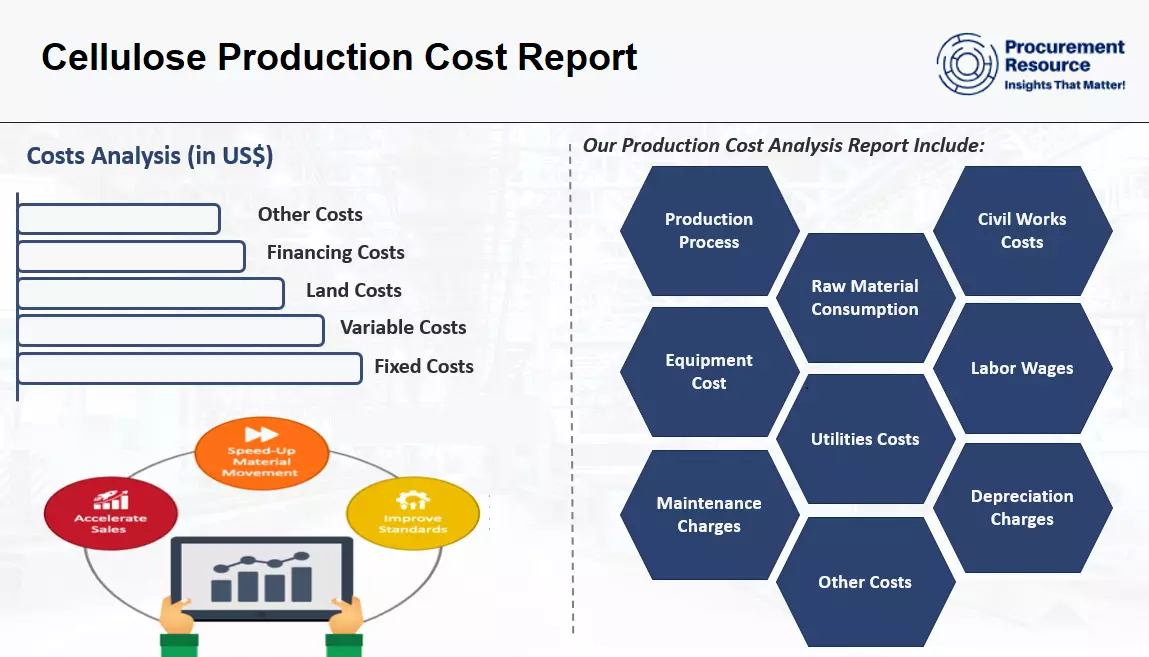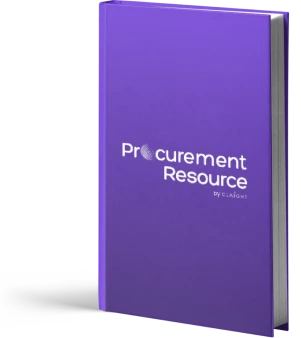Cellulose Production Cost Reports
Chemicals
The report provides a detailed analysis essential for establishing a Cellulose manufacturing plant. It encompasses all critical aspects necessary for Cellulose production, including the cost of Cellulose production, Cellulose plant cost, Cellulose production costs, and the overall Cellulose manufacturing plant cost. Additionally, the study covers specific expenditures associated with setting up and operating a Cellulose production plant. These encompass manufacturing processes, raw material requirements, utility requirements, infrastructure needs, machinery and technology requirements, manpower requirements, packaging requirements, transportation requirements, and more.

Cellulose is an organic compound that is primarily applied in making paper, where cellulose is separated from lignin using the kraft process. Furthermore, its fibres find application in the textile industry, where it helps create rayon. In the food industry, microcrystalline cellulose and powdered cellulose find use as drug fillers as well as food thickeners, emulsifiers, and stabilizers. In thin-layer chromatography, it is used in liquid filtration. Moreover, it is also used as a building material and electrical insulator.
In everyday household materials, it and often finds usage in making products such as coffee filters, sponges, glues, eye drops, laxatives, and films. It can also be used as an important fuel; moreoverfor instance, cellulose derived from animal waste can be processed to produce butanol biofuel. Other uses of the product include its use as a fibre supplement in the diet, as a food additive, for cheese production, for preservation and as an anti-clumping agent, production of nitrocellulose and in making explosives.
The market for Cellulose is predominantly driven by its extensive usage in producing paper and cardboard products, textiles such as rayon, building materials, and as an insulator, which promotes its market growth and propels its demand in pulp & paper, textile, building materials & construction, and electrical insulation industries. It also finds extensive applications as drug fillers, food thickeners, stabilizers, and emulsifiers, which significantly boosts its demand in the food and pharmaceutical industries.
Additionally, its utilization for the production of biofuels, nitrocellulose, explosives and in various household products like coffee filters, glues, laxatives, films, etc., altogether helps in strengthening its demand in the biofuels, chemical manufacturing, and household & personal care industries on a large scale. Furthermore, several factors influence industrial cellulose procurement, such as the availability and cost of production of cellulose’s feedstock (softwood, etc.), cellulose market prices, distribution (including trading and shipping), logistics, regulatory compliance, environmental regulations, safety standards, etc.
Raw Material for Cellulose Production
According to the Cellulose manufacturing plant project report, the major raw material for Cellulose production includes Softwood (Pine, Fir, Spruce)-Sodium Hydroxide-Carbon Disulfide.
Manufacturing Process of Cellulose
The extensive Cellulose production cost report consists of the following industrial manufacturing process:
- Production from softwood: The process begins with chipping and pulping (Kraft pulping process) the wooden logs. The pulp obtained is further bleached and purified to get rid of impurities such as lignin and hemicellulose, followed by its treatment with sodium hydroxide and carbon disulfide to break down the cellulose fibers producing high cellulose-containing pulp. It can further be processed to obtain various products, such as cellophane and rayon.
Cellulose, with the chemical formula (C6H10O5)n, is a complex carbohydrate or polysaccharide consisting of oxygen, carbon, and hydrogen. It comprises about 3,000 or more glucose units and has functions like providing strength and rigidity to plant cells. Cellulose is one of the most abundantly available organic compounds in nature. This complex carbohydrate's properties are based on its degree of polymerization or chain length and the number of glucose molecules comprising the polymer molecule. By nature, it is biodegradable and chiral. It appears to be a white powder that has no taste or odour.
It is also insoluble in water and most organic solvents. It has a molecular weight and density of about 162.1406 g/mol and 1.5 g/cm³, respectively. It has a melting point of 260–270 °C. It has many vital derivatives, most of which are biodegradable and are renewable resources. Its compounds are usually non-toxic and non-allergenic, including Celluloid, Cellophane, Rayon, Cellulose acetate, Ethulose, Ethyl hydroxyethyl cellulose, Cellulose triacetate, Nitrocellulose, Methylcellulose, Cellulose sulfate, Hydroxypropyl methylcellulose, Carboxymethyl cellulose (cellulose gum).
Cellulose Production Cost Processes with Cost Analysis

Cellulose or Dissolving Pulp Production from softwood
The study offers a detailed cost analysis of Cellulose or Dissolving Pulp Production from softwood. In addition, the report incorporates the manufacturing process with detailed process and material flow, operating costs along with financial expenses and depreciation charges.
Details: Germany - based plant Q1 2025 From $ 2499.00 USD
Product Details
| Particulars | Details |
|---|---|
| Product Name | Cellulose |
| Scope |
Manufacturing Process: Process Flow, Material Flow, Material Balance uipment Costs, Contingency, Engineering and Consulting Charges, Working Capital |
| Currency | US$ (Data can also be provided in the local currency) |
| Pricing and Purchase Options | Basic: US$ 2499 Premium: US$ 3499 Enterprise: US$ 4799 |
| Customization Scope | The report can be customized as per the requirement of the customer |
| Post-Sale Analysts Report | 10-12 weeks of post-purchase analyst support after report delivery for any queries from the deliverable |
| Delivery Format | PDF and Excel format through email (editable version in PPT/Word format of the report can be also provided on special request) |
How does our Cellulose Production Cost Report Provide Exhaustive Data and Extensive Insights?
At Procurement Resource, we not only focus on optimizing the should cost of production for Cellulose but also provide our clients with extensive intel and rigorous information on every aspect of the production process. By utilizing a comprehensive cost model, we help you break down expenses related to raw materials, labor, and technology, offering clear pathways to savings. We also assist in evaluating the capital expenditure (CAPEX) and operating expenses (OPEX), which are often measured as cost per unit of production, such as USD/MT, ensuring that your financial planning is aligned with industry benchmarks.
We offer valuable insights on the top technology providers, in-depth supplier database, and best manufacturers, helping you make informed decisions to improve efficiency. Additionally, we design the most feasible layout for your production needs, ensuring the entire process runs smoothly. By minimizing the cash cost of production, we ensure that you stay competitive while securing long-term profitability in the growing Cellulose market. Partnering with Procurement Resource guarantees that every aspect of your production is cost-efficient, advanced, and tailored to your specific requirements.
Key Questions Answered in This Report
- What are the key requirements for setting up a Cellulose manufacturing plant?
- How is Cellulose manufactured?
- What is the process flow involved in producing Cellulose?
- What are the raw material requirements and costs for producing Cellulose?
- What is the total size of land required for setting up a Cellulose manufacturing plant?
- What are the construction requirements for setting up a Cellulose manufacturing plant?
- What are the machinery requirements for producing Cellulose?
- What are the utility requirements and costs for producing Cellulose?
- What are the manpower requirements for producing Cellulose?
- What are the average salaries/wages of manpower working in a Cellulose manufacturing plant?
- What are the packaging requirements and associated costs for Cellulose?
- What are the transportation requirements and associated costs for Cellulose?
- What are the capital costs for setting up a Cellulose manufacturing plant?
- What are the operating costs for setting up a Cellulose manufacturing plant?
- What should be the price of Cellulose?
- What will be the income and expenditures for a Cellulose manufacturing plant?
Need more help?
- We can tailor the report as per your unique requirements such as desired capacity, future expansion plans, product specifications, mode of financing, plant location, etc.
- We can also provide a flexible, easy-to-use, dynamic excel-based cost-model/ dashboard where you can change the inputs to get different outputs
- Speak to our highly skilled team of analysts for insights on the recent trends and innovations, industry best practices, key success and risk factors, product pricing, margins, return on investment, industry standards and regulations, etc.
- Gain an unparalleled competitive advantage in your domain by understanding how to optimize your business operations and maximize profits
- For further assistance, please connect with our analysts
Compare & Choose the Right Report Version for You

You can easily get a quote for any Procurement Resource report. Just click here and raise a request. We will get back to you within 24 hours. Alternatively, you can also drop us an email at sales@procurementresource.com.
RIGHT PEOPLE
At Procurement Resource our analysts are selected after they are assessed thoroughly on having required qualities so that they can work effectively and productively and are able to execute projects based on the expectations shared by our clients. Our team is hence, technically exceptional, strategic, pragmatic, well experienced and competent.
RIGHT METHODOLOGY
We understand the cruciality of high-quality assessments that are important for our clients to take timely decisions and plan strategically. We have been continuously upgrading our tools and resources over the past years to become useful partners for our clientele. Our research methods are supported by most recent technology, our trusted and verified databases that are modified as per the needs help us serve our clients effectively every time and puts them ahead of their competitors.
RIGHT PRICE
Our team provides a detailed, high quality and deeply researched evaluations in competitive prices, that are unmatchable, and demonstrates our understanding of our client’s resource composition. These reports support our clientele make important procurement and supply chains choices that further helps them to place themselves ahead of their counterparts. We also offer attractive discounts or rebates on our forth coming reports.
RIGHT SUPPORT
Our vision is to enable our clients with superior quality market assessment and actionable evaluations to assist them with taking timely and right decisions. We are always ready to deliver our clients with maximum results by delivering them with customised suggestions to meet their exact needs within the specified timeline and help them understand the market dynamics in a better way.
SELECT YOUR LICENCE TYPE
- Review the available license options and choose the one that best fits your needs. Different licenses offer varying levels of access and usage rights, so make sure to pick the one that aligns with your requirements.
- If you're unsure which license is right for you, feel free to contact us for assistance.
CLICK 'BUY NOW'
- Once you've selected your desired report and license, click the ‘Buy Now’ button. This will add the report to your cart. You will be directed to the registration page where you’ll provide the necessary information to complete the purchase.
- You’ll have the chance to review your order and make adjustments, including updating your license or quantity, before proceeding to the next step.
COMPLETE REGISTRATION
- Enter your details for registration. This will include your name, email address, and any other necessary information. Creating an account allows you to easily manage your orders and gain access to future purchases or reports.
- If you already have an account with us, simply log in to streamline the process.
CHOOSE YOUR PAYMENT METHOD
- Select from a variety of secure payment options, including credit/debit cards, PayPal, or other available gateways. We ensure that all transactions are encrypted and processed securely.
- After selecting your payment method, you will be redirected to a secure checkout page to complete your transaction.
CONFIRM YOUR PURCHASE
- Once your payment is processed, you will receive an order confirmation email from sales@procurementresource.com confirming the dedicated project manger and delivery timelines.
ACCESS YOUR REPORT
- The report will be delivered to you by the project manager within the specified timeline.
- If you encounter any issues accessing your report, project manager would remain connected throughout the length of the project. The team shall assist you with post purchase analyst support for any queries or concerns from the deliverable (within the remit of the agreed scope of work).
